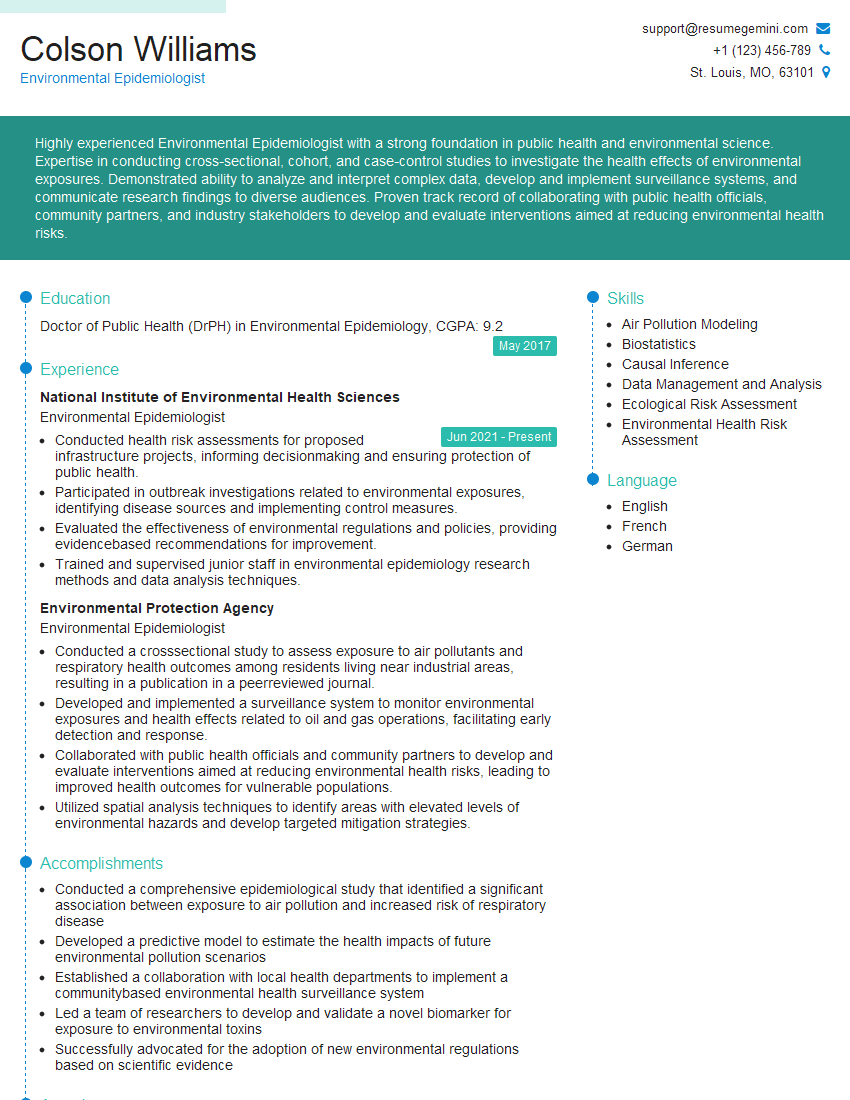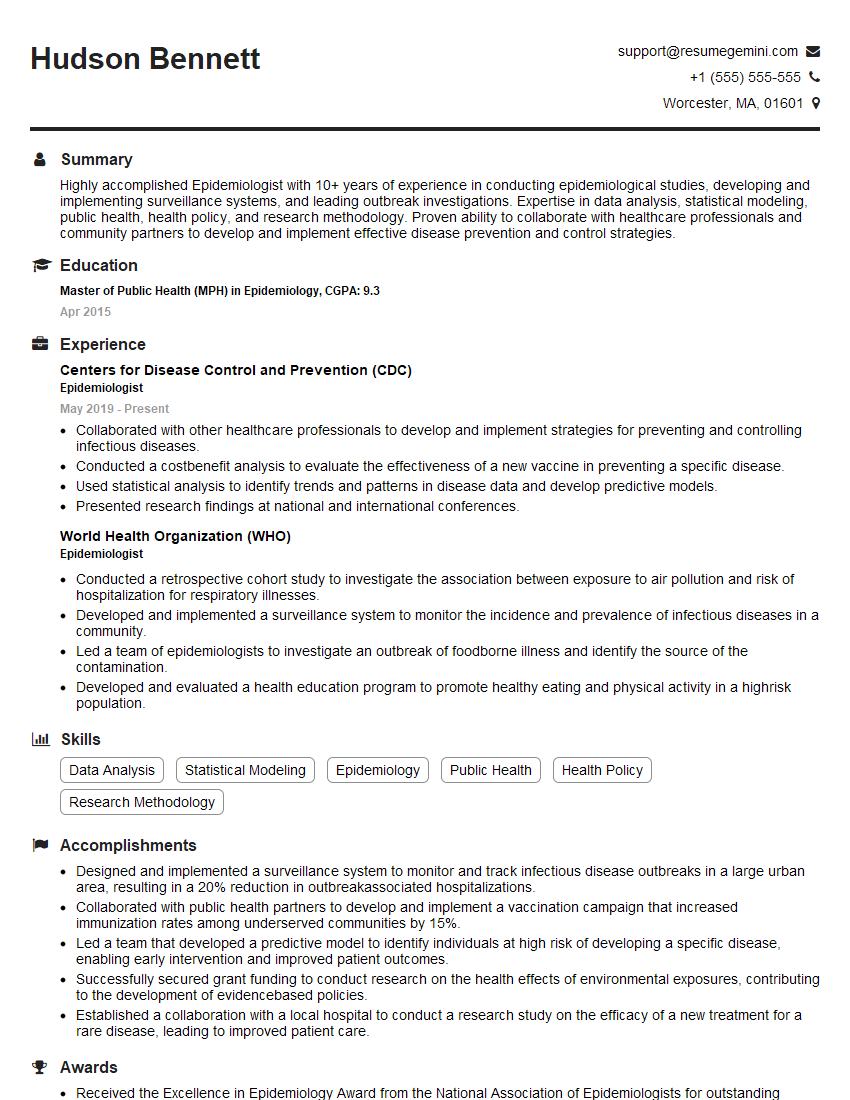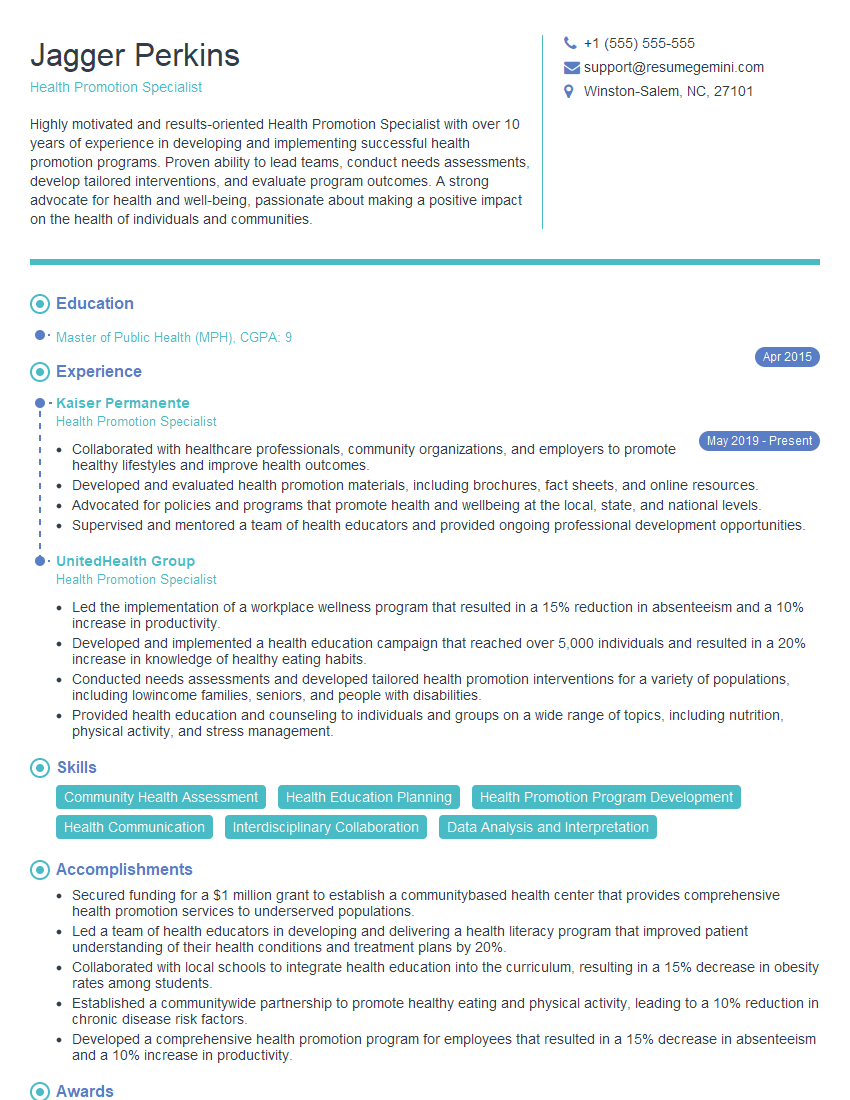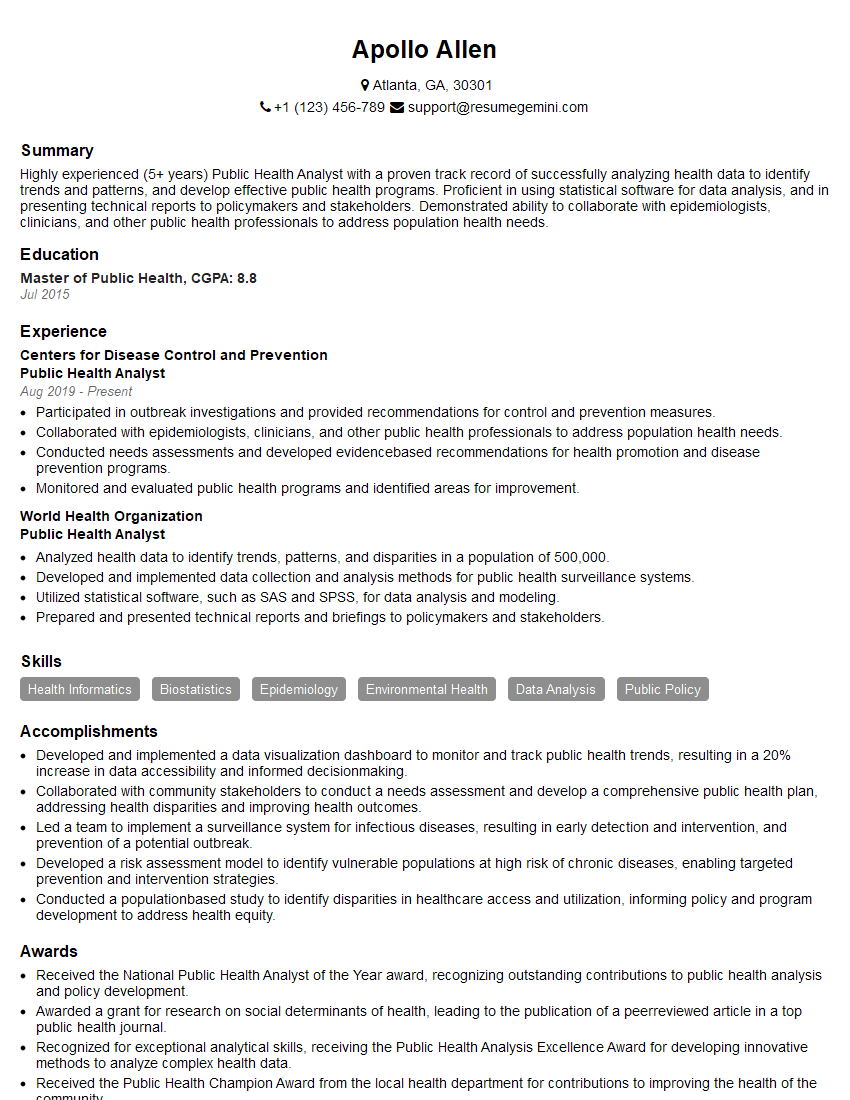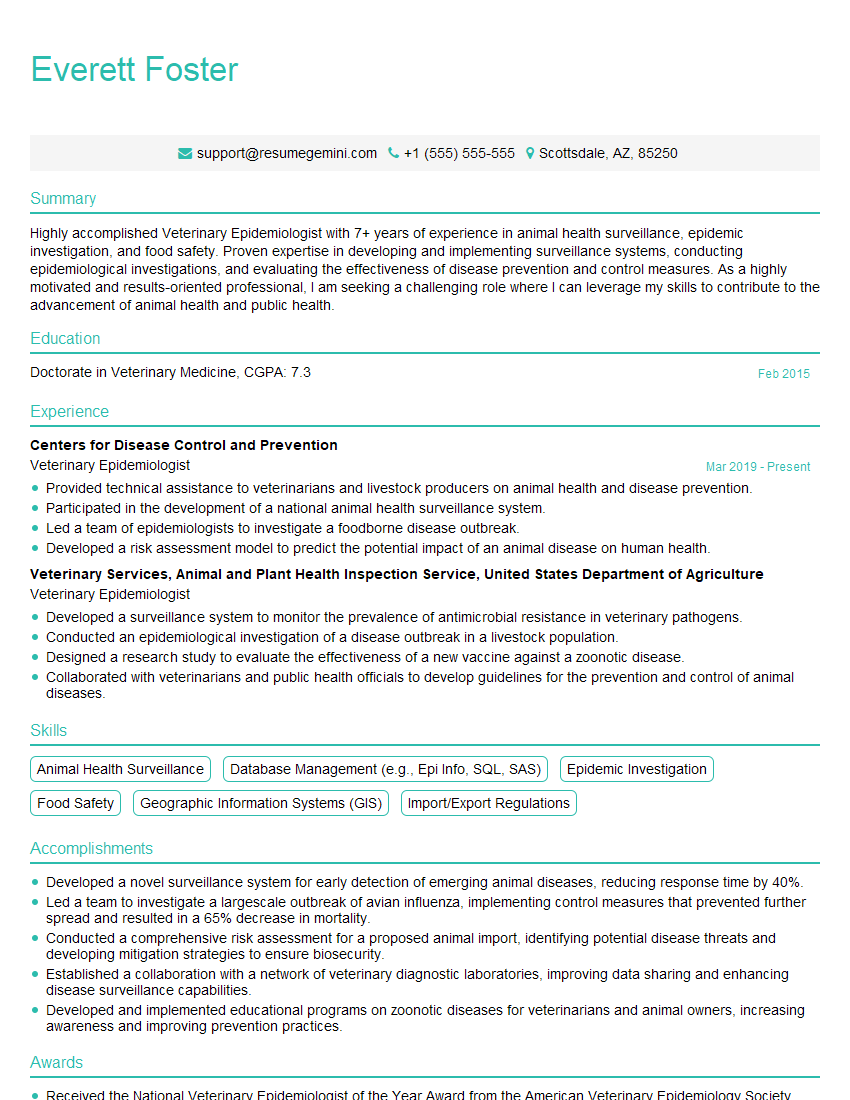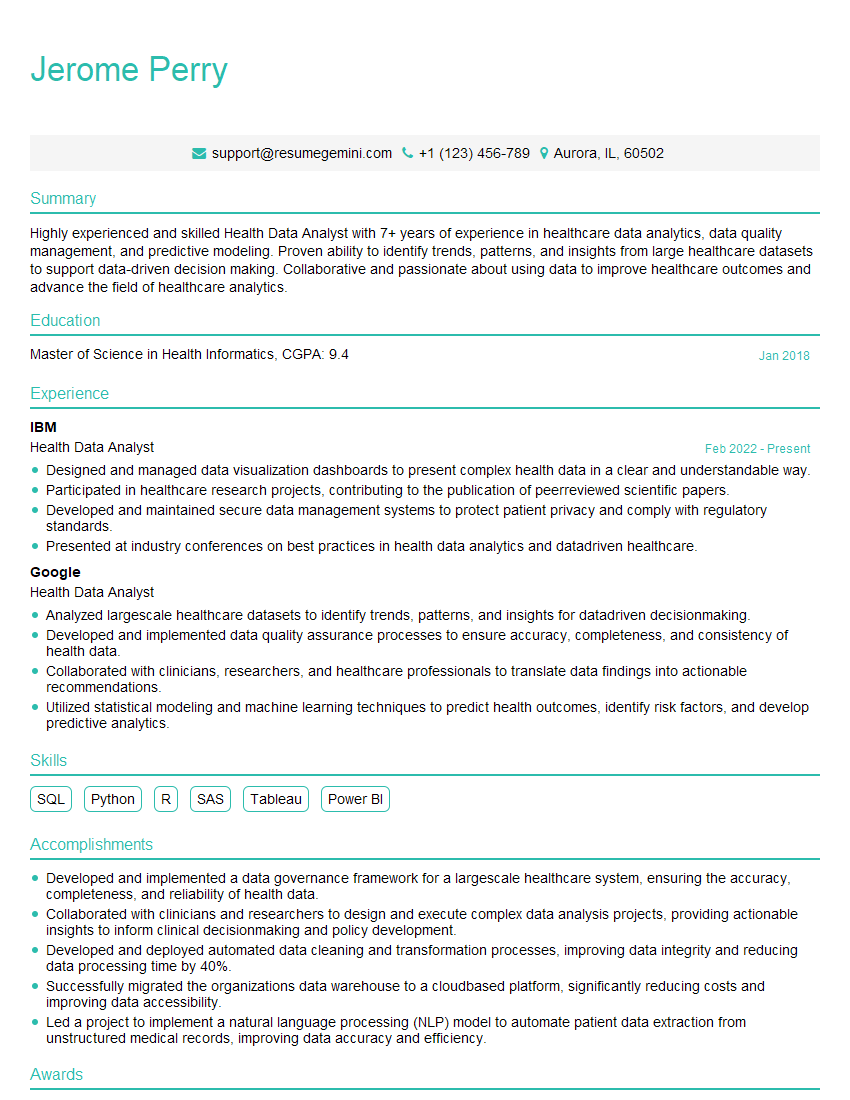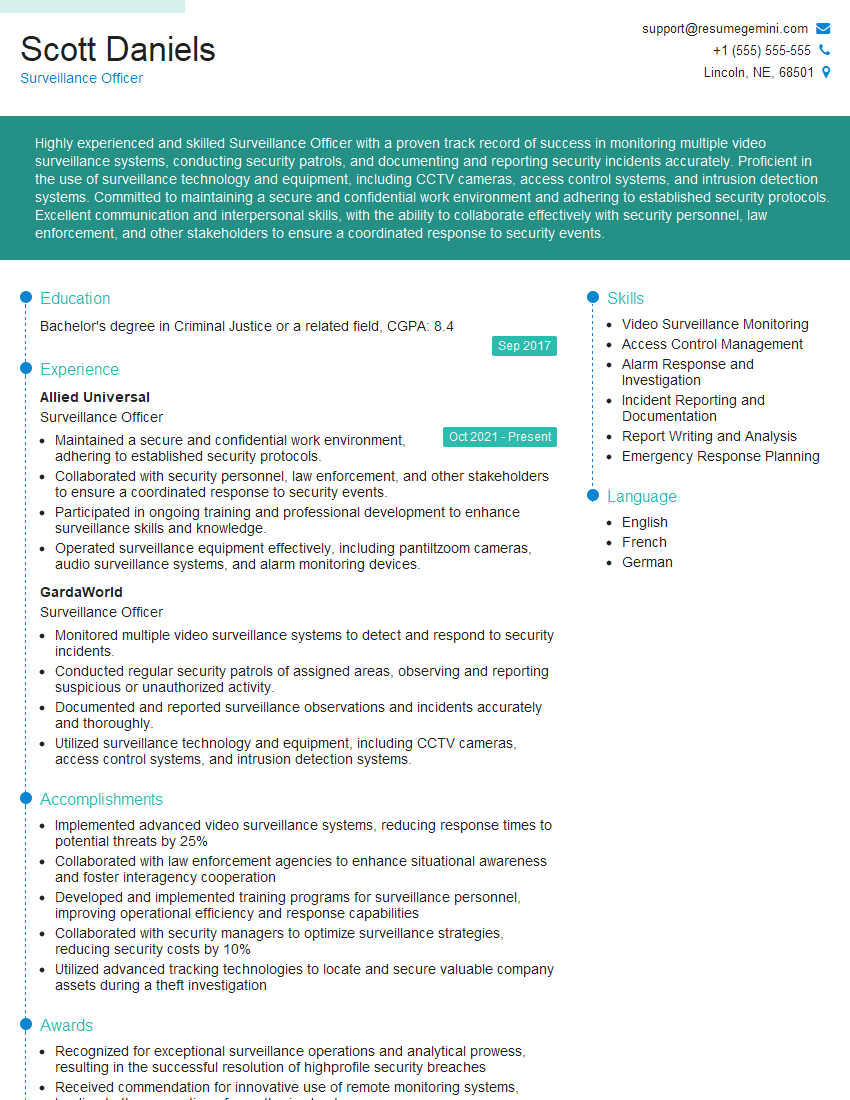Unlock your full potential by mastering the most common Communicable Disease Surveillance and Control interview questions. This blog offers a deep dive into the critical topics, ensuring you’re not only prepared to answer but to excel. With these insights, you’ll approach your interview with clarity and confidence.
Questions Asked in Communicable Disease Surveillance and Control Interview
Q 1. Define communicable disease surveillance and its core components.
Communicable disease surveillance is the ongoing, systematic collection, analysis, interpretation, and dissemination of data regarding the occurrence of infectious diseases. It’s the cornerstone of public health, allowing us to understand disease patterns, predict outbreaks, and implement effective control measures. Its core components include:
- Data Collection: This involves gathering information on cases from various sources like hospitals, laboratories, and primary care providers. This data might include demographics, symptoms, dates of onset, and potential exposures.
- Data Analysis: This step involves analyzing the collected data to identify trends, patterns, and outbreaks. Epidemiological methods like calculating attack rates and relative risks are crucial here.
- Data Interpretation: This goes beyond simple analysis, involving drawing conclusions from the data to understand the disease’s epidemiology and inform public health actions. For instance, identifying a cluster of cases in a specific geographic area points to a potential outbreak.
- Data Dissemination: Finally, the findings are shared with relevant stakeholders, including public health officials, healthcare providers, and the public, to facilitate timely and effective responses.
Imagine it like a sophisticated early warning system for infectious diseases. By constantly monitoring, we can anticipate and mitigate potential threats.
Q 2. Explain the difference between active and passive surveillance systems.
Active and passive surveillance systems differ significantly in their approach to data collection. Passive surveillance relies on healthcare providers and laboratories reporting cases of diseases to public health authorities. Think of it like waiting for information to come to you – it’s cost-effective but relies on the diligence of reporters and may miss less severe or unreported cases. Active surveillance, on the other hand, is much more proactive. Public health officials actively seek out cases, often through contacting healthcare providers, conducting surveys, or reviewing lab results. This ensures a more comprehensive picture, even if it’s more resource-intensive. For example, during an influenza epidemic, health authorities might actively contact doctors to check the number of influenza cases.
A simple analogy: Passive is like fishing with a rod (waiting for the fish to bite), while active is like using a net (actively capturing the fish). Both methods have their merits and are often used in conjunction.
Q 3. Describe the process of outbreak investigation, from initial detection to control measures.
Outbreak investigation follows a systematic process. It begins with initial detection – often noticing a higher-than-expected number of cases of a specific disease. Next comes verification, where we confirm the diagnosis and rule out other possibilities. Then, case definition is established – clear criteria for identifying cases are developed to ensure consistency. The next step is descriptive epidemiology – gathering information on the time, place, and person characteristics of the cases to identify patterns and risk factors (e.g., a map showing case locations). After establishing the hypothesis, analytical epidemiology follows using methods to identify the probable source and mode of transmission. Finally, we implement control measures, which might involve vaccination, isolation, quarantine, or environmental interventions.
For example, consider a sudden increase in gastrointestinal illness in a school. The investigation would involve confirming the diagnosis, defining cases (e.g., vomiting and diarrhea within 24 hours), identifying potential sources (contaminated food), and implementing control measures like disinfecting the kitchen and advising affected individuals to stay home.
Q 4. What are the key indicators used to monitor the effectiveness of communicable disease control programs?
Several key indicators help us monitor the effectiveness of communicable disease control programs. These include:
- Incidence rates: The number of new cases over a given period. A decrease indicates program success.
- Prevalence rates: The total number of cases at a specific point in time. A decline points to effective control.
- Mortality rates: The number of deaths due to the disease. Lower mortality rates show improved outcomes.
- Case fatality rates (CFR): The proportion of cases that result in death. A lower CFR reflects improved treatment and prevention.
- Vaccination coverage rates: The percentage of the population vaccinated. Higher rates are linked to better protection.
By tracking these indicators over time, we can assess whether programs are achieving their intended goals and make necessary adjustments.
Q 5. How do you assess the reliability and validity of surveillance data?
Assessing the reliability and validity of surveillance data is crucial for evidence-based decision-making. Reliability refers to the consistency of the data – do repeated measurements yield similar results? We can assess this through methods such as inter-rater reliability (do multiple people interpret the data the same way?) and test-retest reliability (are results consistent over time?). Validity refers to the accuracy of the data – does it actually measure what it intends to measure? We assess validity through sensitivity (the ability to correctly identify true cases) and specificity (the ability to correctly identify those without the disease). These are often evaluated using statistical methods comparing surveillance data to other more precise datasets, like those from clinical trials or laboratory studies. For example, comparing surveillance data of influenza cases to laboratory confirmed influenza cases can tell us about the sensitivity and specificity of the surveillance system.
Q 6. Explain different methods for calculating attack rates and case fatality rates.
Attack rate measures the proportion of people exposed to an infectious agent who develop the disease. It’s calculated as:
Attack Rate = (Number of people who developed the disease / Number of people exposed) x 100
For example, if 20 out of 100 people exposed to contaminated food developed food poisoning, the attack rate is 20%.
Case fatality rate (CFR) measures the proportion of people diagnosed with a disease who die from it. It’s calculated as:
Case Fatality Rate = (Number of deaths due to the disease / Number of cases of the disease) x 100
If 5 out of 100 people diagnosed with a particular disease died, the CFR is 5%.
Q 7. What are the ethical considerations in communicable disease surveillance and response?
Ethical considerations are paramount in communicable disease surveillance and response. Key concerns include:
- Confidentiality and privacy: Protecting the identity and sensitive information of individuals with infectious diseases is crucial. Data should be anonymized whenever possible, and strict data security measures must be in place.
- Informed consent: Individuals should be informed about the purpose of surveillance activities and their rights regarding data collection and use. Consent should be obtained whenever appropriate.
- Transparency and accountability: Surveillance processes and data should be transparent and open to scrutiny. Decisions made based on surveillance data should be justified and accountable.
- Non-discrimination: Surveillance and response efforts should not discriminate against any group based on race, ethnicity, socioeconomic status, or other factors.
- Resource allocation: Ethical considerations arise when allocating limited resources to control different infectious diseases, prioritizing those that pose the greatest public health threat.
A balanced approach is essential – protecting individual rights while safeguarding public health. Clear guidelines and robust ethical review processes are necessary to ensure responsible and ethical practices.
Q 8. Describe the role of laboratory testing in communicable disease surveillance.
Laboratory testing is the cornerstone of communicable disease surveillance. It provides the definitive diagnosis needed to confirm suspected cases, understand the circulating strains of pathogens, and monitor the effectiveness of control measures. Without lab confirmation, surveillance relies on potentially inaccurate clinical diagnoses, hindering effective response.
For example, a suspected outbreak of influenza-like illness requires lab testing (e.g., RT-PCR, viral culture) to confirm the presence of influenza viruses and differentiate them from other respiratory pathogens. This allows for targeted interventions like antiviral medication distribution or vaccination campaigns.
Furthermore, laboratory testing allows for characterization of pathogens. Antimicrobial susceptibility testing helps determine the appropriate antibiotics to use, preventing the spread of antibiotic-resistant strains. Genetic sequencing can track the evolution of pathogens, providing insights into transmission patterns and the emergence of new variants. This information is critical for guiding public health decisions.
Q 9. How do you interpret and use epidemiological data to inform public health interventions?
Epidemiological data, such as incidence rates, case fatality rates, and risk factors, are crucial for informing public health interventions. My approach involves a systematic process:
- Data Description and Visualization: I begin by summarizing the data through descriptive statistics and creating clear visualizations (e.g., maps, charts) to identify trends and patterns. This initial step is crucial to understanding the scope and nature of the problem.
- Hypothesis Generation: Based on the observed patterns, I develop hypotheses about the causes and spread of the disease. For instance, a high incidence rate in a specific geographic area might suggest a point source outbreak.
- Analytic Epidemiology: I use appropriate statistical methods (e.g., regression analysis, time series analysis) to test the hypotheses and identify risk factors. This step helps determine the effectiveness of various interventions.
- Intervention Planning and Evaluation: Finally, I use the findings to inform and evaluate public health interventions. For example, identifying a specific risk factor allows for targeted interventions, like educational campaigns or environmental modifications. Post-intervention surveillance measures are implemented to assess the effectiveness.
For instance, during an outbreak of a foodborne illness, analyzing epidemiological data like the foods consumed by affected individuals would allow us to identify the contaminated source and initiate appropriate recall measures.
Q 10. What are the challenges in implementing effective surveillance systems in resource-limited settings?
Implementing effective surveillance systems in resource-limited settings faces numerous challenges:
- Limited Infrastructure: Lack of adequate healthcare facilities, reliable transportation, and communication networks hinders data collection and reporting.
- Shortage of Skilled Personnel: Insufficient training and staffing of healthcare workers limits the quality and consistency of data collected.
- Financial Constraints: Limited funding restricts access to diagnostic equipment, reagents, and essential supplies, impeding laboratory testing capabilities.
- Data Management Challenges: Inadequate data management systems and the lack of electronic health records make it difficult to track and analyze data effectively.
- Political and Social Factors: Political instability, social inequalities, and mistrust in public health authorities can lead to underreporting and difficulties in implementing control measures.
Addressing these challenges requires a multifaceted approach including investing in health infrastructure, training healthcare workers, strengthening data management systems, and building trust within communities.
Q 11. Explain the concept of herd immunity and its role in disease control.
Herd immunity refers to the indirect protection from an infectious disease that occurs when a large percentage of a population is immune, either through vaccination or prior infection. This protects those who are not immune because there are fewer susceptible individuals for the pathogen to spread to.
Think of it like a forest fire: if most of the trees are fire-resistant (immune), the fire (disease) will struggle to spread and won’t cause a large-scale conflagration. The threshold for achieving herd immunity varies depending on the disease and its characteristics, such as its mode of transmission and its reproductive number (R0), which represents the average number of individuals an infected person will infect.
Herd immunity is crucial for disease control, especially for diseases that are highly contagious and for which vaccines might not be 100% effective. It significantly reduces the risk of outbreaks and protects vulnerable populations like infants or immunocompromised individuals who cannot be vaccinated.
Q 12. How do you communicate complex epidemiological data to diverse audiences?
Communicating complex epidemiological data to diverse audiences requires careful planning and tailoring the message to the specific audience’s knowledge and understanding.
- Use Simple Language: Avoid technical jargon and use clear, concise language that is easily understood by non-experts.
- Visual Aids: Employ charts, graphs, maps, and infographics to present data visually appealing and accessible.
- Storytelling: Use personal stories and relatable examples to make the information more engaging and memorable.
- Tailored Messaging: Adapt the message and delivery method based on the audience. For example, communicate with healthcare providers using more technical language, while providing simplified information for the general public.
- Multiple Channels: Use diverse channels to reach different audiences – press releases, social media, community meetings, educational materials.
For example, when communicating about a flu outbreak, I’d use different approaches: I’d give detailed epidemiological data to healthcare professionals in technical reports, while providing simple updates and preventive measures to the general public via social media and public health announcements.
Q 13. What are the different types of epidemiological study designs, and when are they most appropriate?
Several epidemiological study designs exist, each with its strengths and weaknesses and best suited for answering specific research questions:
- Descriptive studies (e.g., case reports, cross-sectional studies): These describe the distribution of disease and identify patterns. Cross-sectional studies provide a snapshot in time, while case reports provide detailed information on individual cases. Useful for generating hypotheses and identifying potential risk factors.
- Analytic studies (e.g., cohort studies, case-control studies, randomized controlled trials): These investigate the association between exposures and outcomes. Cohort studies follow groups over time, while case-control studies compare exposed and unexposed groups. Randomized controlled trials are the gold standard for assessing the effectiveness of interventions.
Choosing the appropriate design depends on the research question, available resources, and ethical considerations. For instance, a cohort study is ideal for investigating the long-term effects of an exposure, while a case-control study is more efficient for studying rare diseases.
Q 14. Describe your experience using statistical software for data analysis (e.g., R, SAS, SPSS).
I have extensive experience using statistical software packages, including R and SPSS, for data analysis in communicable disease surveillance. My proficiency includes data cleaning, descriptive statistics, regression modeling (e.g., logistic regression, Poisson regression), and time series analysis. I regularly use R for epidemiological modeling, particularly for infectious disease transmission modeling, often employing packages like EpiModel and incidence.
For example, I’ve utilized R to analyze surveillance data to identify temporal trends in disease incidence, spatial clusters, and risk factors associated with disease transmission. In SPSS, I’ve performed statistical analyses to assess the effectiveness of interventions and generate reports for public health officials. My work with these tools helps to translate raw data into actionable insights which inform public health policy and resource allocation. I’m also proficient in data visualization using ggplot2 in R to create compelling and informative graphics for presentations and reports.
Q 15. How do you manage conflicting information from multiple sources during an outbreak investigation?
Managing conflicting information during an outbreak is crucial. It often involves data from various sources – labs, hospitals, clinicians, and even social media – each with its own reporting biases and potential inaccuracies. My approach is systematic and involves several steps:
Source Verification: I meticulously assess the credibility of each source. This includes evaluating the methodology used to collect the data, the expertise of the individuals or organizations providing it, and the potential for bias or conflict of interest. For example, I might give more weight to lab-confirmed cases than self-reported symptoms from social media.
Data Triangulation: I look for corroborating evidence. If multiple independent sources report similar findings, it strengthens the validity of the information. Discrepancies, however, trigger further investigation. For example, if one hospital reports a significant surge in cases, but others don’t, I’d investigate potential reporting delays or local factors in that hospital’s data.
Data Reconciliation: When discrepancies exist, I investigate the root cause. This might involve contacting the source for clarification, reviewing data collection methods, or conducting additional investigations. Sometimes, the data is reconciled by adjusting the denominator (population size, time period), clarifying case definitions, or identifying reporting errors.
Qualitative Data Integration: Quantitative data needs the context of qualitative information. This involves interviews with healthcare workers, community members, and potentially affected individuals to understand the ‘why’ behind the data. For instance, understanding community practices might help explain unexpected patterns.
Transparent Documentation: I meticulously document all sources, data discrepancies, and the rationale behind any decisions made, ensuring transparency and accountability throughout the process.
Career Expert Tips:
- Ace those interviews! Prepare effectively by reviewing the Top 50 Most Common Interview Questions on ResumeGemini.
- Navigate your job search with confidence! Explore a wide range of Career Tips on ResumeGemini. Learn about common challenges and recommendations to overcome them.
- Craft the perfect resume! Master the Art of Resume Writing with ResumeGemini’s guide. Showcase your unique qualifications and achievements effectively.
- Don’t miss out on holiday savings! Build your dream resume with ResumeGemini’s ATS optimized templates.
Q 16. Describe your experience with data visualization and presentation techniques.
Data visualization is essential for effective communication during outbreaks. I’m proficient in various techniques, including:
Geographic Information Systems (GIS): Mapping the spatial distribution of cases helps identify clusters and pinpoint high-risk areas. For example, using GIS to map cases on a city map allowed for a targeted intervention in a particular neighborhood during a foodborne illness outbreak.
Line graphs and bar charts: These are useful for demonstrating trends over time, showing the rise and fall of cases, and comparing different epidemiological parameters. A line graph, for instance, is ideal for displaying the daily number of new cases over a period of weeks.
Epi curves: These are crucial for identifying the incubation period and pattern of an outbreak. They reveal the shape of the outbreak, helping us determine if it’s a point-source (single event) or propagated (person-to-person) outbreak.
Infographics: These condense complex information into easily digestible visuals, enhancing communication with the public and stakeholders. This was crucial in communicating the risks of the influenza virus during an epidemic.
I also utilize presentation software such as PowerPoint and Tableau to create engaging and informative presentations, tailored to the audience’s level of understanding. I always aim for clarity, accuracy, and avoidance of technical jargon whenever possible.
Q 17. How do you ensure data security and privacy in communicable disease surveillance?
Data security and privacy are paramount in communicable disease surveillance. We adhere to strict protocols to protect sensitive patient information, complying with regulations like HIPAA (in the US) and GDPR (in Europe). My experience involves:
Data anonymization and de-identification: Removing or modifying identifying information before analysis and sharing protects individual privacy. We use techniques like removing names, addresses, and other direct identifiers, ensuring the data remains confidential.
Secure data storage and access control: We use encrypted databases, password-protected systems, and role-based access control to limit access to authorized personnel only. This prevents unauthorized access and data breaches.
Regular security audits and vulnerability assessments: We conduct these assessments to identify and address any potential security weaknesses in our systems, updating security protocols as needed.
Data encryption during transmission: Secure protocols like HTTPS ensure data confidentiality during transmission between systems, preventing interception by unauthorized parties.
Employee training and awareness: Regular training sessions educate staff on data security best practices, emphasizing responsible data handling and the importance of data privacy.
We also maintain detailed records of all data access and modifications, facilitating tracking and accountability. We prioritize ethical data management, understanding the sensitivity of the information and the potential impact of breaches.
Q 18. What is your understanding of the importance of risk assessment in communicable disease control?
Risk assessment is fundamental to effective communicable disease control. It involves identifying populations at risk, evaluating the likelihood and potential severity of outbreaks, and determining the resources needed for prevention and control efforts. It’s a proactive approach, allowing us to prioritize our efforts and allocate resources effectively.
A comprehensive risk assessment considers several factors:
Agent characteristics: The infectious agent’s virulence, transmissibility, and resistance to treatment influence the risk level.
Host factors: Susceptibility of the population, age, underlying health conditions, immunity levels all affect the risk.
Environmental factors: Climate, sanitation levels, population density, and healthcare infrastructure can influence transmission dynamics.
Vector/Reservoir: For vector-borne diseases, the presence and abundance of vectors (mosquitoes, ticks) and reservoirs (animals) are critical risk factors.
The results of the risk assessment inform the development of tailored interventions, such as vaccination campaigns, targeted screening programs, or public health messaging, ensuring efficient allocation of limited resources. For example, during an influenza outbreak, a risk assessment would identify vulnerable groups like the elderly and those with compromised immunity to warrant preferential access to vaccination.
Q 19. Explain your experience working with different stakeholders (e.g., healthcare providers, communities).
Collaboration is essential in communicable disease control. I have extensive experience working with diverse stakeholders, including:
Healthcare providers: Effective communication with clinicians is vital for early detection, case reporting, and appropriate management of cases. I’ve facilitated training sessions for healthcare professionals on updated guidelines and reporting protocols.
Public health laboratories: Collaboration with labs ensures timely testing, accurate diagnosis, and effective monitoring of outbreaks. This is a crucial aspect for prompt disease characterization and informing public health actions.
Community leaders and organizations: Engaging with community leaders and groups builds trust, ensures effective communication, and promotes community participation in control measures. Community involvement is essential in culturally sensitive public health interventions.
Government agencies: Collaboration with local, regional, and national authorities is crucial for resource allocation, policy implementation, and coordination of outbreak response efforts.
I use various communication strategies, including regular meetings, presentations, training sessions, and written reports, to ensure effective and transparent communication across stakeholders. I value building trust and strong working relationships with all those involved, fostering cooperation and enabling quick and efficient responses to health threats.
Q 20. Describe a time you had to make a critical decision under pressure during a public health emergency.
During a significant influenza outbreak, we faced a critical shortage of antiviral medications. The pressure was immense, as cases were surging, and hospital beds were filling rapidly. We had to make a difficult decision on how to allocate the limited supply.
My team and I developed a tiered allocation system based on risk stratification. We prioritized patients with severe disease, underlying health conditions, and those at highest risk of complications. This was ethically challenging as difficult choices were required. The decision involved:
Ethical considerations: We ensured that the allocation criteria were transparent, fair, and equitable, considering factors like age, underlying health conditions, and potential for severe complications.
Data-driven approach: We used epidemiological data to identify high-risk populations and areas with the greatest need.
Transparency and communication: We communicated the allocation criteria to all stakeholders, explaining the rationale behind our decisions. This was crucial to maintain public trust and support during a tense period.
While it wasn’t an easy decision, the tiered approach enabled us to maximize the impact of the limited resources, saving lives and reducing the severity of the outbreak.
Q 21. What are the key elements of a successful communicable disease prevention and control plan?
A successful communicable disease prevention and control plan has several key elements:
Surveillance system: A robust system for detecting, reporting, and investigating outbreaks is crucial for early warning and timely intervention. This includes laboratory capacity, case reporting mechanisms and analysis capabilities.
Risk assessment and prioritization: Regular risk assessments identify high-risk populations, agents, and settings, allowing for targeted interventions and resource allocation.
Prevention strategies: These include vaccination programs, health promotion campaigns, hygiene education, infection control measures, and environmental modifications to reduce transmission opportunities. This might involve promotion of hand washing, safe sex practices or vector control.
Early detection and response: Rapid detection and response are critical to controlling outbreaks, involving case investigation, contact tracing, and isolation/quarantine measures. This relies on effective case investigation, contact tracing systems and resource mobilization strategies.
Treatment and care: Access to appropriate diagnosis, treatment, and supportive care is crucial for reducing morbidity and mortality, requiring access to effective medications and healthcare infrastructure.
Communication and community engagement: Effective communication is essential to build public trust, disseminate information, promote preventative behaviors, and increase community participation.
Capacity building and training: Investing in the training and development of healthcare professionals, laboratory personnel, and public health officials is critical for sustaining a robust response system.
Evaluation and feedback: Regular evaluation of the plan’s effectiveness is essential to make adjustments, optimize strategies, and identify areas for improvement. This requires data collection, analysis and adaptation to ensure effectiveness.
A successful plan is adaptive, flexible, and responsive to evolving threats, ensuring its effectiveness in protecting public health.
Q 22. How do you stay up-to-date on the latest advancements in communicable disease surveillance and control?
Staying current in the dynamic field of communicable disease surveillance and control requires a multi-faceted approach. I regularly consult several key resources to ensure my knowledge remains sharp. This includes subscribing to and actively reading peer-reviewed journals such as the American Journal of Epidemiology and the Emerging Infectious Diseases journal. These publications provide in-depth analysis of the latest research findings and emerging trends.
I also actively participate in professional development opportunities, such as attending conferences like those hosted by the Centers for Disease Control and Prevention (CDC) and the World Health Organization (WHO). These events provide a platform to network with leading experts and learn about the most recent advancements in the field.
Furthermore, I leverage online resources like the CDC’s website and ProMED-mail, which offer up-to-date information on outbreaks and disease surveillance data globally. Finally, I maintain memberships in relevant professional organizations, such as the Society for Public Health Education, which provides access to newsletters, webinars, and continuing education modules keeping me informed about best practices and policy changes.
Q 23. Explain your understanding of different infectious disease transmission routes.
Infectious diseases spread through various transmission routes. Understanding these routes is crucial for effective control measures. We categorize these routes primarily into:
- Direct Contact: This involves direct physical contact between an infected person and a susceptible person, such as through touching, kissing, or sexual contact. Examples include sexually transmitted infections (STIs) like gonorrhea and syphilis.
- Indirect Contact: This occurs when a susceptible person comes into contact with a contaminated object or surface, such as a doorknob or shared utensil. Influenza can spread this way.
- Droplet Transmission: This involves the spread of respiratory droplets produced during coughing, sneezing, or talking. These droplets travel short distances and can infect individuals nearby. Measles and influenza are common examples.
- Airborne Transmission: This is similar to droplet transmission, but involves smaller particles that remain suspended in the air for longer periods and can travel further distances. Tuberculosis is an example of a disease spread via airborne transmission.
- Vector-borne Transmission: This involves the transmission of disease through an intermediate vector, typically an arthropod such as a mosquito or tick. Malaria and Lyme disease are examples.
- Fecal-Oral Transmission: This occurs when infectious agents are ingested through contaminated food or water. Cholera is a classic example.
Knowing the dominant transmission route for a particular disease guides the selection of appropriate control measures, such as quarantine, isolation, or vector control.
Q 24. Describe your experience in developing and implementing public health interventions.
Throughout my career, I’ve been involved in numerous public health interventions, from developing and implementing strategies to evaluating their effectiveness. For instance, during a mumps outbreak in a local community, I played a key role in the development and implementation of a vaccination campaign. This involved collaborating with local health departments, schools, and community organizations to reach target populations. We used a multi-pronged approach that included targeted vaccination efforts, public education campaigns leveraging social media and local news outlets, and contact tracing to prevent further spread.
In another project, I was involved in the design and implementation of a health education program aimed at reducing the transmission of sexually transmitted infections among young adults. This program employed various strategies including interactive workshops, peer education, and the creation of educational materials tailored to the target audience. Evaluation of this program involved collecting pre- and post-intervention data on knowledge, attitudes, and behaviors related to STI prevention. The data informed ongoing refinements to the program’s design to maximize its impact.
These experiences highlight my ability to work collaboratively across sectors, leverage data-driven decision-making, and tailor interventions to specific community needs.
Q 25. How would you handle a situation where surveillance data reveals a potential public health threat?
The detection of a potential public health threat through surveillance data requires a rapid and coordinated response. My approach would involve the following steps:
- Data Verification and Validation: The first step is to thoroughly verify and validate the surveillance data to confirm the potential threat. This involves checking for data entry errors, comparing the data to historical trends, and exploring possible confounding factors.
- Risk Assessment: A comprehensive risk assessment is crucial to determine the severity and potential impact of the threat. This involves assessing factors such as the transmissibility of the disease, the severity of illness, the potential for widespread spread, and the vulnerability of the population.
- Alert and Collaboration: Based on the risk assessment, appropriate authorities (e.g., local health department, CDC) should be immediately alerted. This would involve close collaboration with relevant partners to initiate a coordinated response.
- Investigation and Case Finding: A thorough investigation is needed to identify cases, trace contacts, and understand the dynamics of the outbreak. This includes implementing enhanced surveillance, laboratory testing, and epidemiological investigations.
- Intervention and Control Measures: Based on the findings of the investigation, appropriate control measures need to be implemented promptly. These measures could include quarantine, isolation, vaccination campaigns, or public health messaging.
- Communication and Transparency: Maintaining transparent communication with the public is vital to building trust and ensuring the community’s cooperation. This involves providing regular updates on the situation, addressing concerns, and promoting evidence-based preventive measures.
Throughout the entire process, data analysis and monitoring remain crucial for guiding decision-making and evaluating the effectiveness of control measures. This iterative process allows for ongoing refinement of the response based on real-time data.
Q 26. What is your experience with disease modeling and forecasting?
I have significant experience utilizing disease modeling and forecasting techniques. My work has involved using various epidemiological models, including compartmental models (SIR, SEIR) and agent-based models, to simulate disease transmission dynamics. This includes using software like R and specialized epidemiological modeling packages.
For example, in a recent project, we used a SEIR model to predict the potential impact of different intervention strategies on the spread of influenza within a large metropolitan area. We varied parameters such as the basic reproduction number (R0), vaccination coverage, and the effectiveness of social distancing measures to evaluate their relative impact on slowing the spread of the disease and reducing hospitalizations. The model’s output provided crucial information that informed public health decision-making regarding resource allocation and intervention prioritization.
My experience extends to using forecasting models to predict future outbreaks and assess the potential burden of disease. These forecasts, while inherently uncertain, provide valuable insights for proactive planning and resource allocation. It’s important to acknowledge the inherent limitations of these models and understand the assumptions underlying their predictions. Regular model calibration and validation are essential to maintain their accuracy and reliability.
Q 27. How would you address concerns from the public regarding a communicable disease outbreak?
Addressing public concerns during a communicable disease outbreak requires a multi-pronged strategy focused on transparency, empathy, and evidence-based communication. The key is building trust and providing reliable information to counteract misinformation and rumors.
My approach would involve:
- Establish a dedicated communication channel: This could involve setting up a website, using social media platforms, or holding regular press briefings. Information should be presented in a clear, concise, and accessible manner, avoiding overly technical jargon.
- Provide timely and accurate updates: Regular updates about the situation, including the number of cases, areas affected, and measures being taken to control the outbreak are vital. Transparency is paramount.
- Address public concerns directly: Actively engage with public inquiries and address concerns openly and honestly. Acknowledge fears and uncertainties, and provide reassurance based on scientific evidence.
- Utilize diverse communication strategies: Tailor communication to different segments of the population, considering factors such as language, literacy, and cultural background. This may involve working with community leaders and trusted organizations to disseminate information effectively.
- Promote evidence-based preventative measures: Clearly communicate preventative measures such as hand hygiene, vaccination, and social distancing. Providing practical guidance empowers individuals to protect themselves and others.
- Counter misinformation: Actively identify and address misinformation and rumors circulating about the outbreak. This could involve working with fact-checkers and media outlets to disseminate accurate information and debunk false claims.
Effective communication during a public health crisis is crucial for minimizing fear, promoting cooperation, and ensuring the success of control measures. It requires a proactive and multi-faceted approach centered on transparency, empathy, and evidence-based communication strategies.
Key Topics to Learn for Communicable Disease Surveillance and Control Interview
- Disease Surveillance Systems: Understanding the principles of different surveillance systems (passive, active, sentinel), their strengths, weaknesses, and appropriate applications in various epidemiological contexts. Consider how data quality impacts analysis and decision-making.
- Epidemiological Investigation: Mastering the steps involved in investigating outbreaks, including case definition, hypothesis generation, data collection and analysis, and control measures implementation. Think about practical challenges in real-world settings and how to overcome them.
- Data Analysis & Interpretation: Proficiency in interpreting epidemiological data, including rates, ratios, and risk factors. Familiarize yourself with common statistical methods used in communicable disease surveillance and their interpretation. Practice visualizing data effectively.
- Public Health Interventions: Understanding various public health interventions for preventing and controlling communicable diseases, including vaccination, case management, contact tracing, and outbreak control strategies. Consider the ethical and logistical considerations.
- Risk Assessment & Communication: Developing skills in assessing the risk posed by communicable diseases and effectively communicating this risk to public health officials, healthcare providers, and the public. Focus on clear and concise messaging tailored to different audiences.
- Emerging Infectious Diseases: Familiarity with the principles of emerging infectious disease surveillance and response, including understanding factors contributing to disease emergence and effective strategies for early detection and containment.
- Data Management & Reporting: Understanding data privacy, security and the regulatory framework surrounding communicable disease data management and reporting. Practice formulating clear and concise reports based on epidemiological findings.
- Legal & Ethical Considerations: A solid understanding of relevant legislation, regulations, and ethical guidelines pertaining to communicable disease surveillance and control, including issues of privacy and informed consent.
Next Steps
Mastering Communicable Disease Surveillance and Control opens doors to impactful careers in public health, significantly advancing your professional growth and contributing to global health security. A strong resume is crucial for showcasing your expertise. To maximize your job prospects, create an ATS-friendly resume that highlights your skills and experience effectively. ResumeGemini is a trusted resource to help you build a professional and compelling resume. They provide examples of resumes tailored to Communicable Disease Surveillance and Control, giving you a head start in crafting your perfect application.
Explore more articles
Users Rating of Our Blogs
Share Your Experience
We value your feedback! Please rate our content and share your thoughts (optional).
What Readers Say About Our Blog
This was kind of a unique content I found around the specialized skills. Very helpful questions and good detailed answers.
Very Helpful blog, thank you Interviewgemini team.

